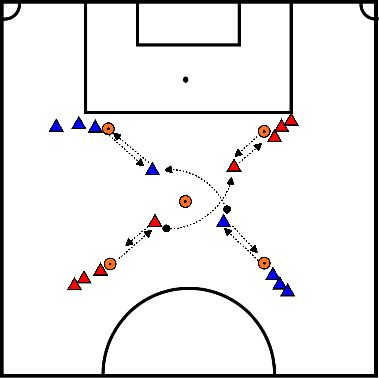Soccer drills
Warming up 3 exercises +- 8 min
- 1st 6 meter sprint next to the field.
- get them ready 1 leg in front 1 behind
- hands next to the body
- each 3x
- 2nd exercise stand on 1 leg other leg bent backwards 20 seconds hold then other leg.
- If this is difficult, you do a round per leg.
- 3rd exercise is with ball on upper leg-> ball on foot and catch both cases.
Dribbling exercises. The goals are 1 meter big
- Dribble through as many goals as possible within a minute.
- They can do this all at the same time.
- But they should not go through a goal at the same time. Make sure they do not wait for each other at a goal then they have to find another goal. If they wait too often, add 2 more goals.
- Dribble 1 ball with pairs. Score by kicking the ball through the goal to your partner.
- Practice for a few minutes, then play. Who scores the most goals within a minute?
- Goals dribbling waste rounds.
- In box have ball dribble on yes sign have ball stop in goal.
- Last one falls off each time until there is 1 winner.
- In this exercise, have the players first dribble and kick the ball into the goal without dropping out.
- Kicking exercise
- 2 goals and pylons at 5 meters, 8 meters and 10 meters. Shoot into goal via inside foot.
- Then hit 1 pylon to the back.
- Make sure the stand leg is next to the ball not against it and pointing towards the goal.
- Make sure the shooting leg is brought to the back and swung straight ahead.
- Correct if they are not doing this correctly.
- Remaining time; party form

1st exercise:
- Player A plays the ball in to B and runs to B's position.
- Player B stands open turned, takes it and passes it to Player C and so on.
- Point of attention playing in:
- the ball must be hit in the middle so that it stays low.
- The correct technique for this is to lift your shooting leg slightly.
- Passing point:
- The player who accepts the ball should not be facing the ball with his or her body, but turned "open". You create this by positioning your body towards the player you are passing to and with your eyes on the ball.
- Playing around clockwise, the ball is taken on with the left and I play on with the right.
- In the other direction take on with the right and play on with the left.
- If you notice it's too easy, first increase the pace. Then to make it more difficult you can take out the assumption and they have to pass the ball directly.
2nd exercise:
- Player B asks for the ball.
- Player A plays into player B.
- Then B then drops the ball to player A after which he passes it back to player C.
- Player C then drops it to player B and then player B plays it diagonally to player D and so on.
Points of attention:
- The player who plays the ball in must move on after the play-in so that he can ask for the ball, in the middle, between the pawns
- Not further because then the effect is gone with the cross pass.
- The player who rebounds runs around his own pawn to ask for the ball again in the middle.
- This player must make the correct turn when rebounding so that he keeps his eyes on the ball.
- His turn should be short toward the box and not off the play.
In both drills after 8 minutes, change directions of play.
Clockwise passes with right leg, counterclockwise passes with left leg.
Clockwise passes with right leg, counterclockwise passes with left leg.
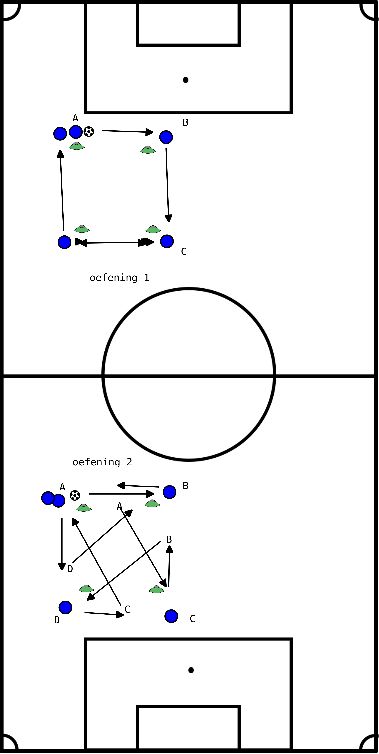
1st exercise:
- Player A plays the ball in to B and runs to B's position.
- Player B is open turned takes it and passes it to Player C and so on.
- Focal point 1 playing in: the ball must be hit in the middle so that it stays low.
- The correct technique for this is to lift your shooting leg slightly.
- Focal point 2 receiving: The player who has to receive the ball should not be facing the ball but rather, as they say, turned open. You create this by positioning your body towards the player you have to pass to and your face is facing the ball. Playing the ball around clockwise, the ball is taken on with the left and I play on with the right. other way round take on with the right and play on with the left.
- If you notice that it is too easy, first increase the tempo. If that also proves too easy then you take out the takeover and they have to pass the ball directly.
2nd exercise:
- Player B asks for the ball, player A plays into player B. Then B drops the ball to player A who then passes it on to player C.
- Player C then drops it to player B and then player B plays it diagonally to player D and so on.
Points of attention:
- The player who plays the ball in must move on after playing in so that he asks for the ball in the middle between the pawns
- Not further because then the cross pass effect is gone.
- The player who bounces the ball back runs around his own pawn to ask for the ball again in the middle.
- It is imperative that this player makes the correct turn when rebounding so that he keeps his eyes on the ball.
- His turn should be short toward the box and not off the play.

- All balls are next to the goal with the trainer.
- The trainer plays the balls to the players.
- The goal is to score. The player who scores stays in the game, while the player who misses or the goalie who stops the ball is out of the game.
- The team with 1 or more players remaining last wins.
- The player who has been goalkeeping makes sure the balls are returned to the coach until players are finished. After that, those players take over.
In groups A through D, players must shoot the ball in front of the 16-yard line. Beyond is off. For groups E through J, the line is halfway between the 5-meter area and the 16-meter line.
- One group starts with goalkeeping, in this case red.
- The trainer plays the ball in and the player from blue runs in and shoots directly at the goal. Don't assume first, then you're off.
- If he hits, he goes goalie and rejoins his group. If he misses, he goes to goal and then collects balls.
- When a player has shot at goal, hit or miss, the next ball from the opponent goes to goalkeeper.
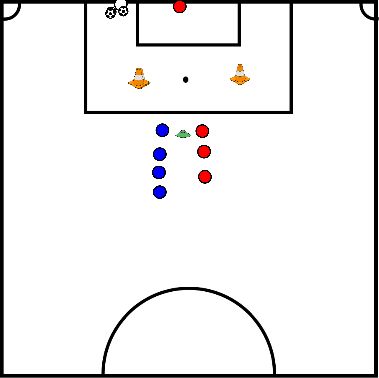
Goal of the exercise is to:
- Pass the ball into the boxes
- Score as many points as possible
- The opposing team's ball may be moved to another box by passing against it with the ball.
- In the youngest groups the distance from the green pawn to the scoring boxes is 5 meters, in the oldest groups it is 8 meters.
- The scoring boxes are 1 meter long and 3 meters wide.

- 2 players face each other
- One is the sender the other the receiver
- The receiver receives and rebounds
- The receiver dribbles sideways several meters without the ball
- The receiver receives the ball again
- The receiver dribbles back without the ball
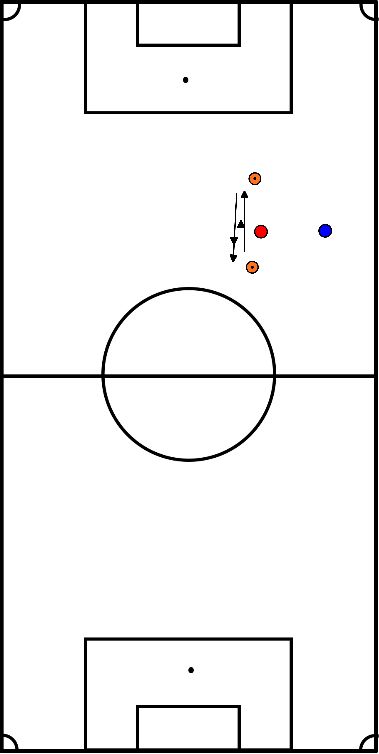
- Players shoot pointedly into the big goal
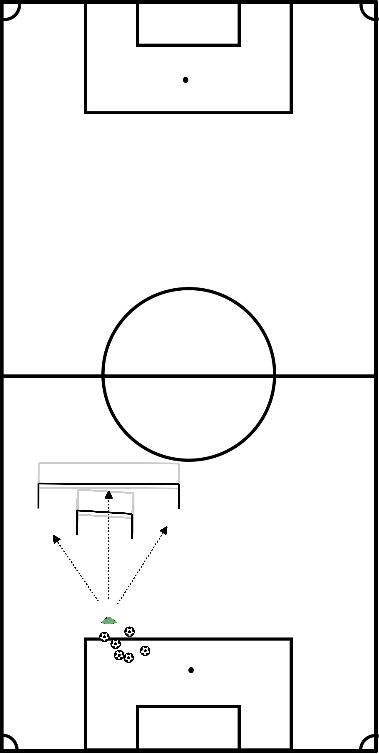
- Standing on one leg with a final goal of 10 seconds sustained with both legs.
- Attention: do not sink into the hip on the standing leg, keep knee slightly bent.
- If not successful, have knee extended or have children find light support from each other.
- Duration: +- 3 minutes.
Players start in 2 groups each at a diagonally opposite corner.
On signal they start the exercise.
On signal they start the exercise.
- As fast as possible over the hurdles, around the cone and duel 1v1. Trainer kicks ball into the field, sometimes with advantage or not.
- Maximum of 20 seconds per duel.
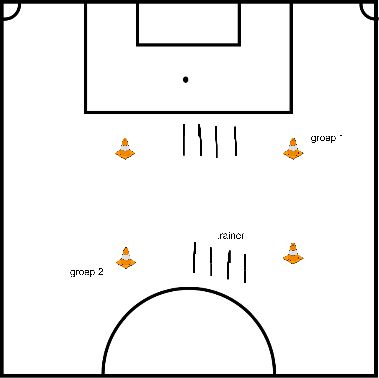
- The team stands ready in 2 groups behind a pawn.
- They are given an exercise by the trainer and do it 1x. On the way back they run back and close behind.
- 2 players run at the same time. The next one leaves when the pair has passed the first hat.
- Exercises:
1. Jogging
2. Knee-up
3. Heel-to-belly
4. Sideways left
5. Sideways right
6. Arms swing front
7. Arms swing back
8. Jump over caps with 2 feet at the same time
9. Sprint to cap and back
10. Shoulder thrust and sprint
- The players form 3 groups
- 2 players stand by 1 pilon and the other opposite.
- The first of the two players receives the balls and plays the player across from her right in the feet. Then this one sprints to the player and stands by the pilon.
- The other takes the ball and plays the ball to the one opposite.
- This repeats itself.
- Because they work in 3 pairs, they are nice and active.
- Variation:
- There is dribbling with the ball at the foot.
- 2 teams are made.
- In the middle is a pylon (or several).
- Teams transfer the ball to other side first by example:
- Throwing over.
- Kick over.
- Dropkick.
- Heading.
- Ball must be placed on the opposite side of the pile.
- After this the next player can do it.
- When the last ball is returned, the pawn in the middle can be kicked over.
